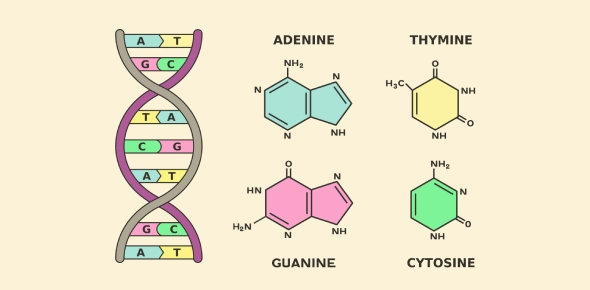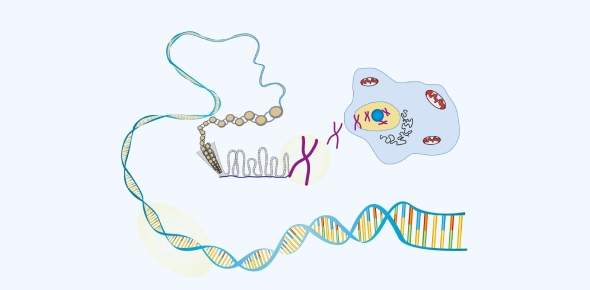DNA Structure and Replication: Understanding How Cells Copy Genetic Information
Lesson Overview
DNA (Deoxyribonucleic Acid) is the molecular blueprint of life. Understanding its structure and replication process is essential to comprehend how traits are inherited and how cells reproduce genetic material. This lesson explores DNA's molecular design and how cells replicate it accurately, preparing students for assessments on the topic.
Structure of DNA
What is DNA?
DNA is a nucleic acid found in nearly every living cell. It encodes instructions for building proteins and controls cellular activities. Most cells in the human body contain DNA, except for mature red blood cells which lack nuclei.
Fact: Over 99.9% of human DNA is identical across individuals.
Composition of DNA
DNA is made of repeating units called nucleotides, each consisting of:
| Component | Description |
| Deoxyribose Sugar | 5-carbon sugar that forms the backbone |
| Phosphate Group | Links sugars, forming the sugar-phosphate backbone |
| Nitrogenous Base | A, T, C, or G – determines genetic code |
Types of Nitrogenous Bases
| Base | Type | Structure | Pairs With |
| Adenine (A) | Purine | Double ring | Thymine (T) |
| Thymine (T) | Pyrimidine | Single ring | Adenine (A) |
| Guanine (G) | Purine | Double ring | Cytosine (C) |
| Cytosine (C) | Pyrimidine | Single ring | Guanine (G) |
Memory Aid:
- "Pure As Gold" – Purines: A and G
- "CUT the Py" – Pyrimidines: C, U (RNA), T
DNA Double Helix
- DNA forms a double helix: two strands twisted around each other.
- Complementary base pairing: A–T and G–C, connected via hydrogen bonds.
- The strands are antiparallel: one runs 5′→3′, the other 3′→5′.
DNA Replication
Purpose of Replication
Replication occurs during the S phase of the cell cycle to ensure each new cell receives an identical copy of DNA before division.
Models of Replication
| Model | Description | Verdict |
| Conservative | Original DNA stays intact, a new copy forms separately | Disproved |
| Dispersive | DNA mixes old and new segments throughout both strands | Disproved |
| Semi-conservative | One old strand, one new strand per daughter DNA | Correct model |
Meselson-Stahl Experiment
Proved DNA replication is semi-conservative using isotope labeling. After one cycle, DNA showed intermediate density, disproving the conservative model.
Key Enzymes and Their Functions
| Enzyme | Role |
| Helicase | Unwinds DNA double helix |
| Topoisomerase | Relieves tension ahead of the fork |
| Single-Strand Binding Proteins (SSBs) | Prevent reannealing of separated strands |
| Primase | Synthesizes RNA primers for DNA polymerase |
| DNA Polymerase III | Adds nucleotides to growing DNA strand (5′→3′ direction) |
| DNA Polymerase I | Removes RNA primers, fills in with DNA |
| DNA Ligase | Seals gaps between Okazaki fragments with phosphodiester bonds |
Steps of DNA Replication
Initiation
- Replication begins at origins of replication.
- Helicase unwinds DNA at the replication fork.
- SSBs stabilize the unwound strands.
Primer Synthesis
- Primase synthesizes a short RNA primer (5–10 nucleotides) to initiate DNA synthesis.
- The primer provides a free 3′-OH end for DNA polymerase.
Take This Quiz:
Elongation
- DNA Polymerase III adds nucleotides in 5′→3′ direction.
- Two strands are synthesized differently due to antiparallel orientation:
| Strand | Template Direction | Synthesis Type | Primer Usage |
| Leading Strand | 3′→5′ | Continuous | One primer |
| Lagging Strand | 5′→3′ | Discontinuous | Multiple primers |
- Okazaki Fragments (~100–200 nucleotides in eukaryotes) are synthesized on the lagging strand.
Primer Replacement and Ligation
- DNA Polymerase I replaces RNA primers with DNA.
- DNA Ligase seals nicks between fragments, forming a continuous strand.
Completion
- Two identical daughter DNA molecules are formed.
- Each contains one parental and one new strand – semi-conservative.
Directionality and Base Pairing
Direction of Replication
- DNA polymerase synthesizes only in the 5′ to 3′ direction.
- Template strand is read 3′ to 5′.
Chargaff's Rule
- %A = %T and %G = %C in DNA.
- Ensures stability and uniform diameter of DNA helix.
Common Misconceptions Clarified
| Misconception | Correction |
| DNA is single-stranded | DNA is double-stranded (double helix) |
| Lagging strand is synthesized 3′→5′ | All strands are synthesized 5′→3′ |
| Ligase is not involved in replication | Ligase is essential to join Okazaki fragments |
| RNA primer is unnecessary | Primers are required to initiate synthesis |
| All cells contain DNA | RBCs and some skin/hair cells lack DNA |
Insights
| Question | Correct Answer | Concept Highlighted |
| What does DNA stand for? | Deoxyribonucleic Acid | Terminology |
| Where is DNA not found? | Red blood cells | Exceptions in cell biology |
| DNA is 99% identical in humans – True/False? | True | Genetic similarity |
| DNA is a single helix – True/False? | False | Double helix structure |
| Nucleotide components | Deoxyribose sugar, phosphate, base | Structural composition |
| Pyrimidines in DNA? | Cytosine, Thymine | Base classification |
| Purines in DNA? | Adenine, Guanine | Base classification |
| Chargaff's rule | A–T, G–C pairing | Base pairing rules |
| Meselson-Stahl disproved which model? | Conservative | DNA replication models |
| DNA replicates via? | Semi-conservative | Replication mechanism |
| Function of DNA Polymerase III? | Adds nucleotides | Enzymatic role |
| How many primers on leading strand? | One | Primer usage |
| DNA replication direction? | 5′ to 3′ | Directionality of synthesis |
| Ligase glues Okazaki fragments with glycosyl bond – True/False? | False (uses phosphodiester) | Enzyme function |
Key Takeaway
DNA's double-helical structure and semi-conservative replication ensure accurate transmission of genetic information. Understanding base pairing, replication direction, and enzyme functions is crucial for mastering this topic. With this foundation, students can confidently answer quiz questions and deepen their grasp of molecular biology.
Take This Quiz:
Rate this lesson:
 Back to top
Back to top

